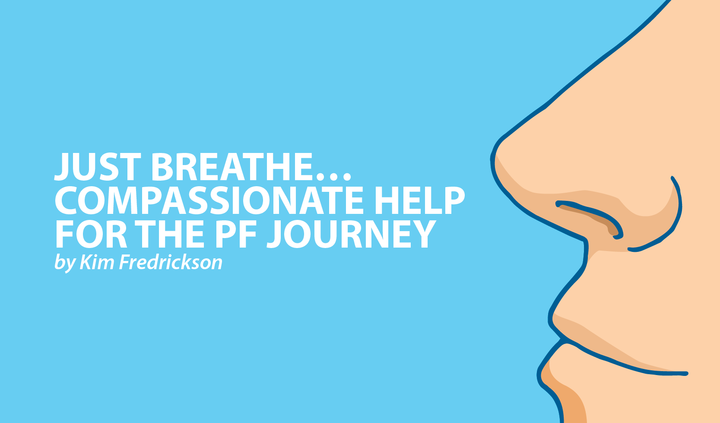Learn to Calm, Soothe Yourself When Distressed by PF

As a patient with pulmonary fibrosis I try to come up with ways to calm myself calm when I’m distressed, discouraged, scared or in pain. Dealing with this diagnosis gives me plenty of opportunities.
The need to soothe ourselves when distressed occurs at all ages for all people. This journey begins as babies suck on pacifiers and clutch soft blankets as they learn to calm down when upset. We aren’t born knowing how to self-soothe.
One of the main ways we learn is by experiencing and observing how our parents or caretakers responded to our needs growing up. If we didn’t learn how to soothe and calm ourselves when distressed, it may be difficult for us to know what to do during distressing times. When distressed, our body and brain goes into overdrive trying to cope with whatever just happened. This causes our system to overload and we don’t know what to do to make things better. The good news is it is not too late to learn.
Treating myself as a friend
For me, learning to treat myself with the kindness and compassion I would give a friend has made a huge difference.
Soothing myself when distressed helps ease the grief and fears I experience. It brings me moments of peace. Recently I received confirmation that my lungs had worsened a little. This is always distressing news. After saying goodbye to my doctor, I made my way to my car, dragging my oxygen tank behind me. I got in the car and sobbed for a while, talking to myself kindly as I absorbed this bad news. I imagined Jesus holding me and letting me cry. I shared this news with my husband when I got home and we were sad together.
I was looking forward to going to a party that evening to spend time with my former colleagues, but I just couldn’t do it. It was a celebration for one of them and I knew I couldn’t go and pretend everything was fine. My husband and I stayed home, ordered take-out and watched a movie. It felt good to be gentle with myself after getting such sad news. I was a good friend to myself by paying attention to how I was doing on the inside, doing things that were soothing, and not forcing myself to expend energy I didn’t have, even with friends I love.
Self-soothing really helps
Such techniques help calm our emotions, thoughts, body sensations (heart rate, blood pressure, sweating), and behavior to a manageable level. We are then able to respond to ourselves in comforting, nurturing, and gentle ways. Knowing how to be there for ourselves in the moment will ground us so that we can be compassionate with ourselves.
How about you?
Take a minute to ask yourself:
- What are some things I’ve done in the past that bring me comfort?
- What type of soothing words do I need to hear from myself right now?
- What kind of music brings me comfort? Could I make a playlist that is ready to go when I need it? If not, who could I ask to create a playlist for me, so I can listen to it on my smartphone?
- Which Bible verses are soothing to my soul? Do I have the strength to mark them in my Bible, make a list I can access on my phone, or print out to have by my bedside? If not, is there a friend who might do this for me?
- Would it help to journal, pray, cry, or take a nap?
- Would it help to call a friend? Is there a friend who would be willing to just listen and be compassionate if I told them that’s what I need right now?
- What helps to reduce my fears and comfort my heart?
- Would it help to get a massage, enjoy my favorite drink, or watch my favorite show?
I hope this column has given you some ideas to help calm yourself when distressed. I’d love for you to share ideas that work for you. We’re in this together. Please leave your comments below, and share via e-mail or social media with anyone you know who could benefit.
Note: Pulmonary Fibrosis News is strictly a news and information website about the disease. It does not provide medical advice, diagnosis, or treatment. This content is not intended to be a substitute for professional medical advice, diagnosis, or treatment. Always seek the advice of your physician or other qualified health provider with any questions you may have regarding a medical condition. Never disregard professional medical advice or delay in seeking it because of something you have read on this website. The opinions expressed in this column are not those of Pulmonary Fibrosis News, or its parent company, Bionews Services, and are intended to spark discussion about issues pertaining to pulmonary fibrosis.
Save








John Archie Henderson
A good article Kim.
Kim Fredrickson
Thanks John...Glad it was helpful :)
Robin
Another excellent article Kim!!
Kim Fredrickson
Thanks so much Robin!
Carol
Kim, I enjoyed reading your article! Thank you for posting it.
The first year of my diagnosis of IPF, I was completely overwhelmed. I went from having moderate hypertension and annual checkups to 3 treating specialists as it turned out, IPF is not my only chronic illness.
All I've ever really sought for myself is to be happy. So, I found a therapist specializing in health psychology. It is the best thing I've ever done for myself. He has helped me find the coping skills for the not so good days and how to deal with family, too.
Kim Fredrickson
Carol, So glad this was helpful. I so appreciate your sharing your process of adjusting to your diagnosis, as well as other chronic illnesses. That is so much to handle! I love your idea of going to a therapist specializing in health psychology to give you support and coping skills. Thanks so much for sharing with us.